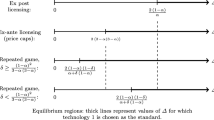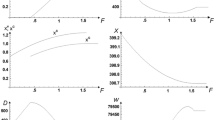Summary
Market-based instruments are believed to create more efficient incentives for firms to adopt new technologies than command-and-control policies. We compare the effects of a direct technology regulation and of an adoption subsidy under asymmetric information about the costs of technological advances in controlling the socially undesirable activities. We show that the policy maker may want to commit to her policy. The reason is that asymmetric information about adoption costs induces the policy maker to set subsidy levels that increase over time; firms, expecting higher subsidies in the future, postpone investment. Direct regulation offers a commitment possibility that allows to prevent firms from postponing investment.
Article PDF
Similar content being viewed by others
Avoid common mistakes on your manuscript.
References
Biglaiser G., Horowitz J.K., Quiggin J. (1995) ‘Dynamic Pollution Regulation’. Journal of Regulatory Economics 8: 33–44
Brainard W.C. (1967) ‘Uncertainty and The Effectiveness of Policy’. American Economic Review 57: 411–425
Buchanan J.M. (1969) ‘External Diseconomies, Corrective Taxes, and Market Structure’. American Economic Review 59: 174–177
Buchanan J.M., Tullock G. (1975) ‘Polluters’ Profits and Political Response: Direct Controls versus Taxes’. American Economic Review 65: 139–147
Cadot O., Sinclair-Desgagn´e B. (1996) ‘Innovation under the Threat of Stricter Environmental Standards,’. In: Carraro C., Katsoulacos Y., Xepapadeas A.(eds) Environmental Policy and Market Structure. Kluwer Academic Publishers, Dordrecht, pp 131–141
Cropper M.L., Oates W.E. (1992) ‘Environmental Economics: A Survey’. Journal of Economic Literature 30: 675–740
Dijkstra B.R. (1999) The Political Economy of Environmental Policy: A Public Choice Approach to Market Instruments. Edward Elgar, Cheltenham, UK
Gersbach H., Glazer A. (1999) ‘Markets and Regulatory Hold-Up Problems’. Journal of Environmental Economics and Management 37: 151–164
Glazer A., Lave Ch. (1996) ‘Regulation by Prices and by Command’. Journal of Regulatory Economics 9: 191–197
Hahn R.W. (1984) ‘Market Power and Transferable Property Rights’. Quarterly Journal of Economics 99: 753–765
Hahn R.W. (1990) ‘The Political Economy of Environmental Regulation: Towards a Unifying Framework’. Public Choice 65: 21–47
Heyes A. (2001) Honesty in a Regulatory Context – Good Thing or Bad? European Economic Review 45: 215–232
Jaffe A.B., Newell R.G., Stavins R.N. (2002) ‘Environmental Policy and Technological Change’. Environmental and Resource Economics 22: 41–69
Laffont J.-J., Tirole J. (1993) A Theory of Incentives in Procurement and Regulation. The MIT Press, Cambridge, Massachusetts
Malik A.S. (1991) ‘Permanent versus Interim Regulations: A Game-Theoretic Analysis’. Journal of Environmental Economics and Management 21: 127–139
Montero J.P. (2002) ‘Market Structure and Environmental Innovation’. Journal of Applied Economics 5: 293–325
Russell, C.S. and Ph.T. Powell (1999), ‘Practical Considerations and Comparison of Instruments of Environmental Policy’. in: J.C.J.M. Van den Bergh (ed.), Handbook of environmental and resource economics. Elgar, Cheltenham, U.K. and Northampton, Mass., pp. 307–328.
Saracho A.I., Usategui J.M. (1994) ‘Innovation Diffusion Subsidies: Supply without Precommitment Ability and Welfare’. European Journal of Political Economy 10: 357–372
Sartzetakis E.S. (1997) ‘Tradeable Emission Permits Regulations in the Presence of Imperfectly Competitive Product Markets: Welfare Implications’. Environmental and Resource Economics 9: 65–81
Stavins R.N. (1995) ‘Transaction Costs and Tradeable Permits’ Journal of Environmental Economics and Management 29: 133–148
Weitzman M.L. (1974) ‘Prices vs. Quantities’. Review of Economic Studies 41: 477–491
Yao D.A. (1988) ‘Strategic Responses to Automobile Emissions Control: A Game-Theoretic Analysis’. Journal of Environmental Economics and Management 15: 419–438
Open Access
This article is distributed under the terms of the Creative Commons Attribution Noncommercial License which permits any noncommercial use, distribution, and reproduction in any medium, provided the original author(s) and source are credited.
Author information
Authors and Affiliations
Corresponding author
Additional information
The research of the the first author was sponsored by the Netherlands Organization for Scientific Research NWO. We thank the participants of the First World Meeting of the Public Choice Society on March 29–April 1, 2007 in Amsterdam, and especially Frans van Winden, for comments.
Rights and permissions
Open Access This is an open access article distributed under the terms of the Creative Commons Attribution Noncommercial License (https://creativecommons.org/licenses/by-nc/2.0), which permits any noncommercial use, distribution, and reproduction in any medium, provided the original author(s) and source are credited.
About this article
Cite this article
Ossokina, I.V., Swank, O.H. Adoption Subsidy Versus Technology Standards Under Asymmetric Information. De Economist 156, 241–267 (2008). https://doi.org/10.1007/s10645-008-9093-2
Published:
Issue Date:
DOI: https://doi.org/10.1007/s10645-008-9093-2




